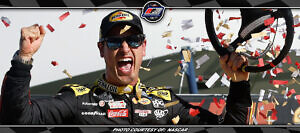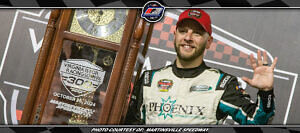
Story By: ZACK ALBERT / NASCAR – DAYTONA BEACH, FL – NASCAR wrapped up a two-day test session for the Next Gen prototype last Wednesday, giving the 2022 Cup Series model its first on-track appearance on the high banks of Daytona International Speedway.
Roush Fenway Racing’s Chris Buescher drove the “P3” vehicle during the shakedown runs at the 2.5-mile Florida track. The second test day concluded early Wednesday afternoon because of approaching rain.
NASCAR competition officials had indicated that one of the top goals of the Next Gen vehicle’s first superspeedway test was establishing a baseline speed in single-car runs, finding the proper balance of horsepower and drag. Pole-winning qualifying speeds have consistently fit in the 194-195 mph range during the last three years. John Probst, NASCAR Senior Vice President of Racing Innovation, said that a target speed was quickly met.
“We did that early in day one,” Probst said. “Then spent the rest of the test trying some new things on steering and also doing some ride-height sweeps just to get some sensitivities in the car to ride height. Nothing surprising, and all good as far as the development of the car.”
Buescher, who is headed into his sixth full season in the Cup Series next year, took his first turn behind the wheel of the P3 car, the product of collaboration between Richard Childress Racing and NASCAR’s Research & Development Department. His experience not only helped to gather data on the car’s performance, but also provided a glimpse at some of the prototype’s new features.
“For starters, the speed, we went through a lot of different changes to try to dial in what we know and get closer on what we don’t know,” Buescher said. “To try to have a competitive race and still do it within a reasonable speed. Just worked through a couple little nuance things that are just a lot different, and honestly it’s a little bit of just mind over matter as far as shifting, trying to make sure you keep pulling backwards for the sequential stuff, which was really neat. I really enjoyed using it and got better as it went, learning what it can and can’t do there by the end. The brakes are terrific and I know this isn’t even a short-track set-up, but they stop extremely well. There’s not going to be any issues getting to pit road and not having the stopping power, just going to be a matter of not spinning out.
“Obviously Daytona single-car is not the most fun kind of testing, but a lot was learned. I’m glad I did it. Even if it’s as little as going back and looking at the car we have at Roush, that we’ve been working on and sitting in, and trying to figure out what we feel like is the right thing to do from my input where the pedals and stuff need to be. Definitely a good test for me. I’m glad I got to drive the thing before we start testing late next year, I’m glad I got the opportunity.”
Probst spelled out the next steps for the Next Gen car, which is scheduled to make its competition debut at Daytona in 2022 — a target date that was delayed a year because of the COVID-19 outbreak. He indicated that some of the learnings from the Tuesday-Wednesday Next Gen sessions at Daytona should apply to other types of speedways moving forward.
“I think some of the stuff we found in the car is very promising for some of the other tracks we’re going to take it to,” Probst said. “So if anything, we may try to get on a local track up in the Charlotte area for a couple hours to verify what we found here translates to some other track types. Right now we’re working with the OEMs and with the teams to establish what our testing schedule will look like next year. We will be working with Goodyear to do a couple more tests with the car, but it will be coming out of the development phase and we’ll be focusing primarily on the tires. We’ll probably do three or four tire tests in the first half of next year for Goodyear.”
Among the other impressions that Buescher noted was the jumble of wires, sensors and other equipment surrounding the driver’s seat — all necessary clutter for the competition team’s data-gathering operations.
“I’ve seen some of the comments on social media talking about how bad the wiring looks inside,” Buescher said. “Well, yes, it’s bad, but it’s because there’s so much in this car that is just for testing purposes. They’re gathering so much information.
“They’re just trying to get from my standpoint what feels right. What’s accurate. What we need feel-wise to back the data up and make it look at the targets going forward. Going through tires, and aero packages and what we think would draft well or be able to put on good racing in a large pack. Try to pick out the little tiny differences in what we do. It’s difficult because the nature of Daytona, you’re really splitting hairs here. I told them a couple times, I don’t know if you’re playing tricks on me or what, I don’t know if I’m getting used to this or if it’s actually gotten better.”







